The cause of many diseases, poor health, is the infection of helminths. Various worms can enter the human body. They range in size from the smallest millimeter to 16-18 meters. They parasitize all organs and tissues and cause enormous damage to health. To protect against invasion, it is desirable to know what worms are and to understand how they can become infected with parasites of each species.
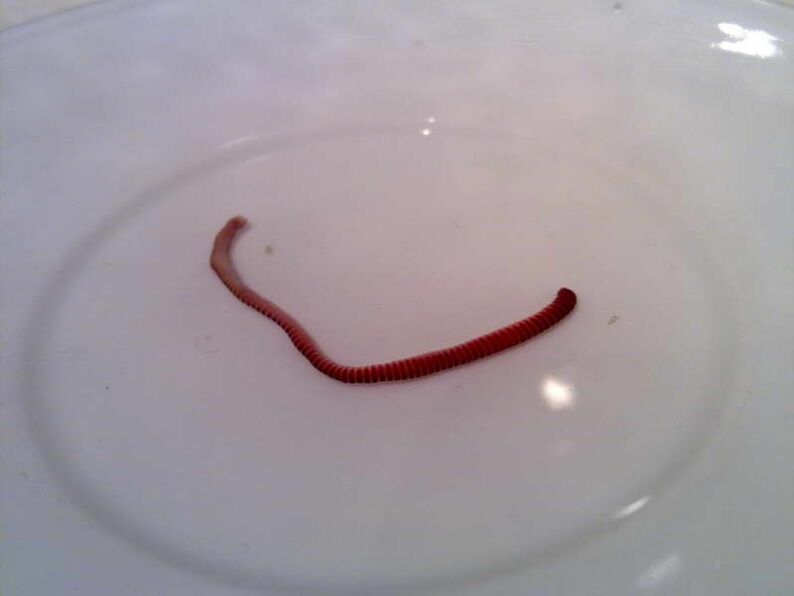
Types of worms - what parasites live in the human body
Depending on the location of the parasite in the body and the characteristics of the infection, the parasites are classified into several classes.
Classification of worms according to their location in the human body:
- Intestine- These are worms that live in the gastrointestinal tract, especially in the small intestine. Sometimes they penetrate other organs. This group includes ribbon and round worms.
- extraintestinal- develop, live and multiply in different organs outside the intestines. They can be localized in the lungs, eyes, brain, liver. Flatworms belong to this group.
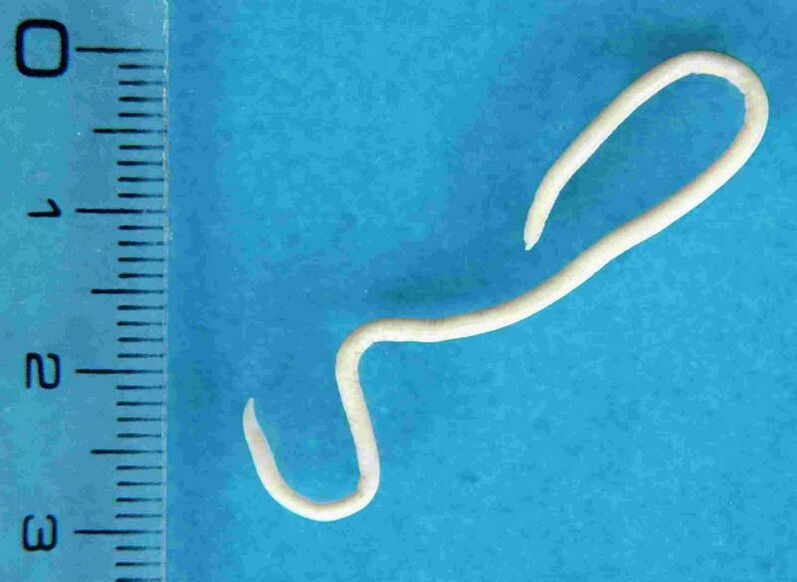
Classification of worms according to the route of entry into the human body:
- infectious- from contact with an infected person to a healthy person. Another source of infection is household items: towels, toys. Representatives of this species are the dwarf tapeworm, the pinworms.
- Biohelminthiasis- are transmitted through contact with an animal as a result of the consumption of infected meat which has not undergone adequate heat treatment. In order to be potentially dangerous to humans, these parasites must live in the body of an intermediate host animal for a period of time. This species includes bovine and porcine earthworms.
- Geohelminthiasis- part of the life cycle takes place in the human body and part in the soil. This is an essential condition for their development. It can become infected through poorly washed vegetables and fruits. This group includes nematodes and trichines.
Depending on the biological characteristics, helminths are divided into three types - round, tapeworms and worms.
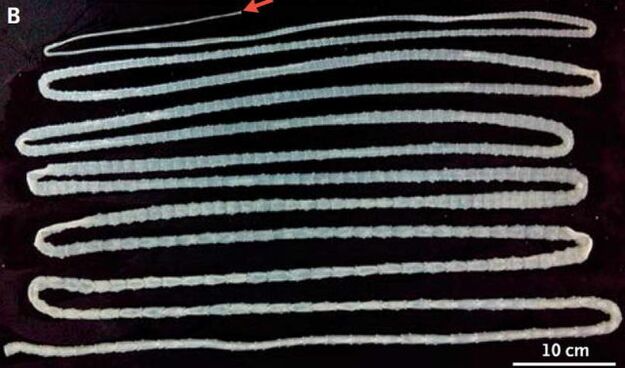
Spindleworms (nematodes)
Spindle worms are so called because their bodies are round in cross section. These parasites are most commonly found in a child’s body. This type includes:
- PinwormsThey parasitize the colon and small intestine. Their body length does not exceed 1 cm. The most common helminthic infestation of fungal worms affects children. These parasites live for 1-2 months. If you adhere to strict personal hygiene, you can recover without taking medication. If this is not followed, re-infection is possible.
- Wormwood- Worms up to 45 cm in size that parasitize the small intestine. They can move freely in the gut. They have a life expectancy of 14 months. During this period, toxins are released into the bloodstream, systematically poisoning the body.
- Vlasoglav- Worms 3-4 cm in length, parasitize the large and caecum, sucking blood into their mucous membranes. Very toxic. Live up to 5 years.
- Trichinella- A parasite with a valley of 3 to 4 mm which may be infected through meat which has undergone an inadequate heat treatment. The helminths live in different organs and settle in the muscles of the eyes, heart and lungs. Life expectancy - up to 2 years.
- hookworm and necator- have the same biological characteristics, developmental cycle and anti-parasitic method and are therefore combined under the same "hookworms". These 10-15 mm long helminths are located in the duodenum. they feed, which leads to iron deficiency anemia. This parasite is difficult to identify.
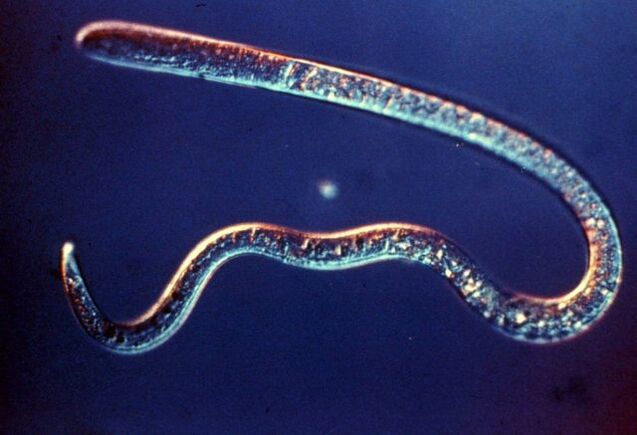
Tapeworms
The tapeworm has a flat body divided into segments. As the worm grows, the segments separate from the body and are excreted with the feces. These strip-like individuals are up to 20 m long. They parasitize the intestines, where they adhere to the walls using suction cups.
To infect humans, tapeworms must go through one of the stages of development in the animal’s body.
These parasites live in the body for years. The members of this group are:
- wide ribbon- reaches a length of 20 m A parasitizes the small intestine, causing severe gastrointestinal disturbances. It can be infected by consuming the meat of freshwater fish and crustaceans that have not undergone heat treatment.
- Bull tapeworm- A 6-12 m long worm that lives in the small intestine and adheres to its mucosa with suction cups. The source of the infection is beef that has undergone improper heat treatment.
- Swine tapeworm- a parasite not exceeding 2 m in length which enters the body through raw or poorly processed pigmeat. It adheres to the wall of the small intestine.
- Echinococcus- parasites can be transmitted from cats and dogs. Man is the intermediate host of this helminth, so when it enters the body, the larvae penetrate the tissues, any organ, and form echinococcus cysts. They are removed only by surgery.
- Alveococcus- a type of echinococcus. Very dangerous helminths that can live in any organ but mainly parasitize the liver. They actively grow and develop according to the principle of cancer metastases, gradually infecting the whole body. Worms can be surgically removed.
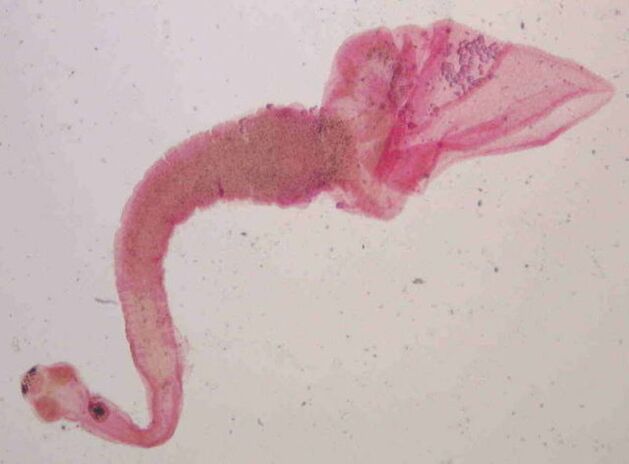
Flukes
Worms are a type of worm that parasitizes any organ and tissue. They feed on epithelial cells. Length reaches 1, 5 m. The body is leaf-shaped. The route of infection is after consuming raw fish, seafood or improper heat treatment. This type includes:
- liverwort- 7-20 mm long worm. It parasitizes the liver and bile ducts. It causes severe diseases and functional disorders.
- Luck- 4-13 mm long worm located in the gallbladder.
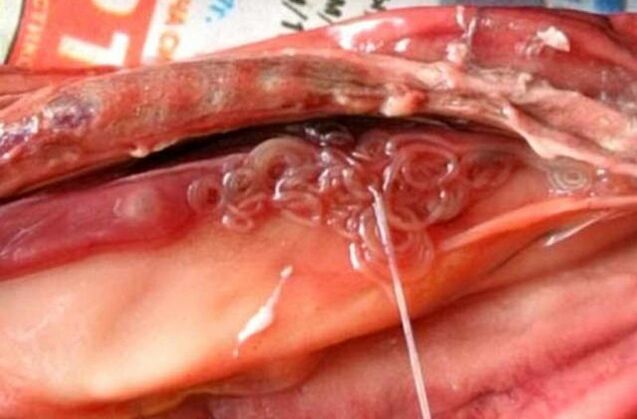
Symptoms - Signs of worms in humans
The exact manifestation of helminthiasis depends on the type and number of worms that affect the body. The main symptoms of helminthic invasion are:
- diarrhea or constipation;
- bloating, bloating;
- muscle and joint pain;
- anemia;
- allergic reactions;
- dermatitis;
- weight problems - weight loss or obesity;
- sleep disorders;
- nervousness, irritability, depression;
- apathy, fatigue;
- cough, respiratory inflammation;
- weakened immunity.

How to tell if there are worms
If you experience symptoms that may indicate the presence of worms, you may want to diagnose them. The following tests will help identify parasites:
- Study of feces.
- Blood test.
- Examination of the secrets of the duodenum.
- Analysis of perianal and rectal mucus.
- Ultrasound, tomography, endoscopy.
You can be sure of the diagnosis if you pass the analysis 3-4 times at several-day intervals. One analysis is not sufficient to confirm the absence of helminthic invasion.
The human body can affect one type of worms or more at a time. All of them, regardless of size, cause serious health problems and are the pathogens of complex chronic diseases that cannot be cured for years. Diagnosis and preventive treatment should be performed regularly to eliminate the risk of infection. This is especially true for animal keepers.






































